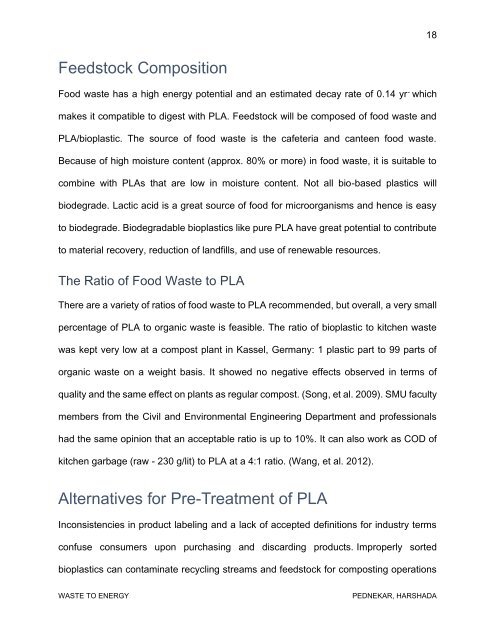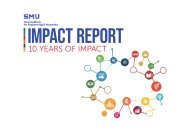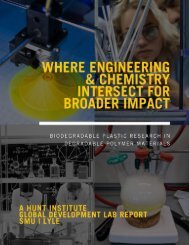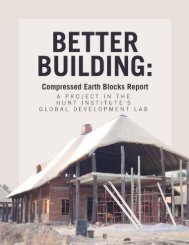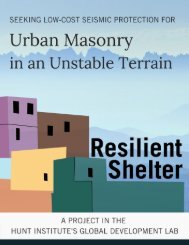Waste to Energy: Harnessing the fuel in organic waste to create a business opportunity for a recycling-based society and system
To generate a feasible amount of methane to support a digester, it is estimated that 10 to 12 tons/d, with 8-10% contamination and 80% of the contamination being bioplastics, can produce about 70 Nm3/h of biogas. This is the amount of biogas needed to produce 200 kg/day of hydrogen, which is the smallest commercially available packaged system. The greenhouse gas emission (GHG) for IngeoTM is currently 1.3 kg CO2 eq./kg polymer compared to approx. 3.2 kg CO2 eq./kg polymer for PET. Therefore, implementing anaerobic digestion for PLA can reduce around 942.5 kg - 1132 kg per day of CO2 equivalent emissions. A total of 1 ton per day of undigested bioplastic with 30% of total solids will be sent to landfills; 3 tons per day of dewatered digestate cake can be utilized for composting, and Class A fertilizer can be produced. The research on anaerobic degradation of biopolymers is still in its infancy. Therefore, this report has discussed different pre-treatment alternatives to treat PLA such as physical, chemical, and thermal treatments. This report suggests on-site segregation benefits of the current solid waste management scenario in the commercial sector of Plano, Texas. Organic waste generated from a cafeteria of the commercial sector in Plano caused an environmental impact on landfills. This report consists of a description of existing scenarios and possible pre-treatment alternatives for bioplastic degradation generated from the commercial sector. Harshada Pednekar was a graduate research analyst in the Hunt Institute while studying for a masters degree in environmental engineering from SMU's Lyle School of Engineering
To generate a feasible amount of methane to support a digester, it is estimated that 10 to 12 tons/d, with 8-10% contamination and 80% of the contamination being bioplastics, can produce about 70 Nm3/h of biogas. This is the amount of biogas needed to produce 200 kg/day of hydrogen, which is the smallest commercially available packaged system. The greenhouse gas emission (GHG) for IngeoTM is currently 1.3 kg CO2 eq./kg polymer compared to approx. 3.2 kg CO2 eq./kg polymer for PET. Therefore, implementing anaerobic digestion for PLA can reduce around 942.5 kg - 1132 kg per day of CO2 equivalent emissions.
A total of 1 ton per day of undigested bioplastic with 30% of total solids will be sent to landfills; 3 tons per day of dewatered digestate cake can be utilized for composting, and Class A fertilizer can be produced. The research on anaerobic degradation of biopolymers is still in its infancy. Therefore, this report has discussed different pre-treatment alternatives to treat PLA such as physical, chemical, and thermal treatments. This report suggests on-site segregation benefits of the current solid waste management scenario in the commercial sector of Plano, Texas. Organic waste generated from a cafeteria of the commercial sector in Plano caused an environmental impact on landfills. This report consists of a description of existing scenarios and possible pre-treatment alternatives for bioplastic degradation generated from the commercial sector.
Harshada Pednekar was a graduate research analyst in the Hunt Institute while studying for a masters degree in environmental engineering from SMU's Lyle School of Engineering
You also want an ePaper? Increase the reach of your titles
YUMPU automatically turns print PDFs into web optimized ePapers that Google loves.
18<br />
Feeds<strong>to</strong>ck Composition<br />
Food <strong>waste</strong> has a high energy potential <strong>and</strong> an estimated decay rate of 0.14 yr - which<br />
makes it compatible <strong>to</strong> digest with PLA. Feeds<strong>to</strong>ck will be composed of food <strong>waste</strong> <strong>and</strong><br />
PLA/bioplastic. The source of food <strong>waste</strong> is <strong>the</strong> cafeteria <strong>and</strong> canteen food <strong>waste</strong>.<br />
Because of high moisture content (approx. 80% or more) <strong>in</strong> food <strong>waste</strong>, it is suitable <strong>to</strong><br />
comb<strong>in</strong>e with PLAs that are low <strong>in</strong> moisture content. Not all bio-<strong>based</strong> plastics will<br />
biodegrade. Lactic acid is a great source of food <strong>for</strong> microorganisms <strong>and</strong> hence is easy<br />
<strong>to</strong> biodegrade. Biodegradable bioplastics like pure PLA have great potential <strong>to</strong> contribute<br />
<strong>to</strong> material recovery, reduction of l<strong>and</strong>fills, <strong>and</strong> use of renewable resources.<br />
The Ratio of Food <strong>Waste</strong> <strong>to</strong> PLA<br />
There are a variety of ratios of food <strong>waste</strong> <strong>to</strong> PLA recommended, but overall, a very small<br />
percentage of PLA <strong>to</strong> <strong>organic</strong> <strong>waste</strong> is feasible. The ratio of bioplastic <strong>to</strong> kitchen <strong>waste</strong><br />
was kept very low at a compost plant <strong>in</strong> Kassel, Germany: 1 plastic part <strong>to</strong> 99 parts of<br />
<strong>organic</strong> <strong>waste</strong> on a weight basis. It showed no negative effects observed <strong>in</strong> terms of<br />
quality <strong>and</strong> <strong>the</strong> same effect on plants as regular compost. (Song, et al. 2009). SMU faculty<br />
members from <strong>the</strong> Civil <strong>and</strong> Environmental Eng<strong>in</strong>eer<strong>in</strong>g Department <strong>and</strong> professionals<br />
had <strong>the</strong> same op<strong>in</strong>ion that an acceptable ratio is up <strong>to</strong> 10%. It can also work as COD of<br />
kitchen garbage (raw - 230 g/lit) <strong>to</strong> PLA at a 4:1 ratio. (Wang, et al. 2012).<br />
Alternatives <strong>for</strong> Pre-Treatment of PLA<br />
Inconsistencies <strong>in</strong> product label<strong>in</strong>g <strong>and</strong> a lack of accepted def<strong>in</strong>itions <strong>for</strong> <strong>in</strong>dustry terms<br />
confuse consumers upon purchas<strong>in</strong>g <strong>and</strong> discard<strong>in</strong>g products. Improperly sorted<br />
bioplastics can contam<strong>in</strong>ate recycl<strong>in</strong>g streams <strong>and</strong> feeds<strong>to</strong>ck <strong>for</strong> compost<strong>in</strong>g operations<br />
WASTE TO ENERGY<br />
PEDNEKAR, HARSHADA


